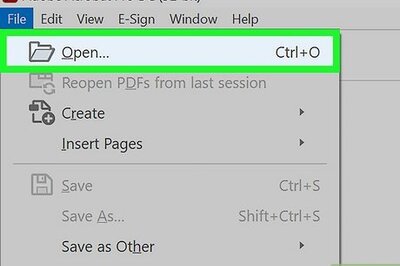
views
Tokyo: Japan Airlines is set to file for bankruptcy on Tuesday, writing Japanese history as one of the nation's biggest corporate failures from which it could emerge a leaner, self-sustaining carrier.
The country's flagship carrier, called JAL for short, will likely convene a special board meeting in the afternoon before filing for protection from creditors under the Corporate Rehabilitation Law--Japan's version of Chapter 11, according to Kyodo News agency. The filing will be followed by a restructuring plan crafted by a government-backed corporate turnaround body.
Airline president Haruka Nishimatsu is expected to resign. Leadership of the company will be handed over to Kazuo Inamori, a Buddhist monk and founder of electronic components behemoth Kyocera Corp. and Japan's No. 2 mobile carrier KDDI Corp.
The government will also offer assurances that it backs the rehabilitation and intends to keep JAL flying.
"The government wants to continue to support JAL to ensure its continued stable and safe operations," said transport minister Seiji Maehara hours before the expected filing.
The day's events culminate a process that began in October when JAL--saddled with debts of 1.5 trillion yen ($16.5 billion) --first turned to the Enterprise Turnaround Initiative Corp. for help. Under a prepackaged restructuring strategy, it will embark on a massive overhaul to shed the fat and inefficiency that hobbled Asia's biggest airline.
Geoffrey Tudor, a principal analyst at Japan Aviation Management Research and former JAL employee, said the airline needs to be leaner and meaner.
"It wasn't commercially brutal enough in dealing with the facts of economic life," said Tudor, who spent 38 years at the Japanese carrier and now watches its collapse with a mixture of sadness and frustration.
The plan calls for about 15,600 job cuts, or a third of JAL's work force, by March 2013 and will require the airline to halve the number of its subsidiaries which span everything from hotels to credit cards, according to Kyodo. The Enterprise Turnaround Initiative Corp. will invest about 300 billion yen ($3.3 billion) in the carrier, and JAL's main lenders have been asked to waive about 350 billion yen in liabilities.
What may take longer to emerge is the winner of a fierce tug-of-war between Delta Air Lines and American Airlines for a slice of JAL's business. Despite its woes, the airline's access to Asia is a mouthwatering prize for foreign airlines.
PAGE_BREAK
Investors on Tuesday braced for a seemingly inevitable removal of the airline's shares from the Tokyo Stock Exchange.
The issue, which has lost more than 90 percent of its value over the last week, tumbled another 40 percent Tuesday to 3 yen at one point. It finished flat at 5 yen. The company is now essentially worthless, with a market capitalization of about 13.7 billion yen ($150 million)--the price of one Boeing 787 jet.
It's a humbling outcome for Japan's once-proud flagship carrier which was founded in 1951 and came to symbolize the country's rapid economic growth. The state-owned airline expanded quickly in the decades after World War II and was privatized in 1987.
But it soon became the victim of its own ambitions.
When Japan's property and stock bubble of the 1980s burst, risky investments in foreign resorts and hotels undermined its bottom line. JAL also shouldered growing pension and payroll costs, as well as a big network of unprofitable domestic routes it was politically obligated to maintain.
"As an airline product, it's always had a high reputation," said Peter Harbison, executive chairman of the Centre for Asia Pacific Aviation, a Sydney-based aviation market research firm. "But from a cost base, it's generally been something of an industry joke."
Inexplicable spending like chauffeuring flight crew to and from home is "an outstanding example of a culture that really shouldn't belong in the 21st century," he said.
More recently, JAL's passenger traffic has slowed amid the global economic downturn, swine flu fears, competition from Japanese rival All Nippon Airways Co. and a spate of safety lapses that tarnished its image. It lost 131.2 billion yen ($1.4 billion) in the six months through September.
Its four government bailouts since 2001 only exacerbated JAL's problems, officials now say. Maehara last week blamed previous administrations, controlled by the opposition Liberal Democrats, for propping up an ailing JAL for years without reforming the company.
Passengers seemed to agree as much.
"I guess they did not work in earnest and so fell into this situation," said Isao Sasaki, 72, who waited in line Tuesday at a JAL check-in counter at Tokyo's Haneda Airport. "Weren't they spoiled as they always had protection from the government?"
Delta Air Lines--the world's biggest airline operator--and rival American Airlines are courting JAL with massive financial offers as the US carriers seek to expand their Asian networks.
Delta and its SkyTeam partners have offered $1 billion, including $500 million in cash to lure JAL away from American's oneworld alliance. American Airlines and its partners say they are ready to inject $1.4 billion cash into the Japanese airline, up from a previous $1.1 billion offer.
As of March, JAL's fleet consisted of 279 aircraft, mainly from Boeing Co. It served 220 airports in 35 countries and territories, including 59 domestic airports.
It carried 11.7 million international passengers last fiscal year and 41.2 million travelers domestically. International traffic was down 12.4 percent from the previous year, while the domestic passenger count fell 1.8 percent.



















Comments
0 comment